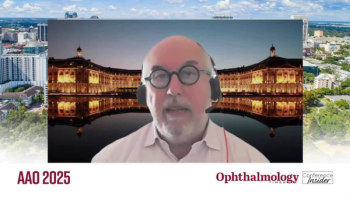
End-stage age-related macular degeneration investigational IOL developed
A prismatic IOL (P-Flex, Rayner) is giving hope to patients with advanced age-related macular degeneration because of its novel design. A Fresnel prism in the IOL reflects images onto healthy retinas in patients with small macular lesions. No scotoma or diplopia has resulted from implantation of this IOL in two patients.
Key Points
The prismatic IOL is an investigational prototype lens with a hydrophilic acrylic platform; anti-vaulting, closed-loop haptics; and a 360° Amon-Apple square edge, Dr. Claoué described. A polymethylmethacrylate optic with a Fresnel prism produces 6° of deviation (1.8 mm at retina for a normal eye), and it has drilled holes for assembly with 9-0 polypropylene (Prolene, Ethicon) and identification of the direction of deviation.
This IOL is a novel method of tackling an old problem, said Dr. Claoué, senior consultant ophthalmic surgeon, Queen's Hospital, London.
"Not much active intervention is possible at present. Ironically, much of the retinal tissue is healthy," Dr. Claoué emphasized.
Two surgical approaches have been tried previously, he said. The first, macular translocation surgery, can be performed only by highly trained surgeons, takes time, and is costly, Dr. Claoué said. Also, he added, some patients lose vision such that the final vision attained is worse than that during the natural progression of the disease.
The second, more recent surgical approach is implantation of an intraocular telescope (VisionCare), Dr. Claoué said. The device is bulky, however, and a large incision is required, making corneal decompensation a concern, he said.
In light of the problems with those surgical procedures, Dr. Claoué and colleagues proposed another idea: rather than move the retina, as in macular translocation surgery, why not deflect the image to healthy retinal tissue? Because a conventional prism is likely to be too bulky to achieve that goal, the investigators suggested using a Fresnel prism.
A few arguments were made against the procedure, he explained, namely, the effect of using a prism is the same as that achieved when a patient looks off to the side (eccentric fixation). Dr. Claoué said that not all patients learn to do this, and he wondered if a Fresnel prism would force them to do so.
Another argument against the IOL was the concern about resultant diplopia. Dr. Claoué countered that, because this had never been done, no one knew the outcome.
In a study conducted by the investigators, the prismatic IOL was implanted in the first two patients in January 2008 in Pretoria, South Africa. Both patients had AMD bilaterally with visual acuities less than 20/200 and macular lesions that were less than 1.5 mm in diameter.
On the first postoperative day, Dr. Claoué reported, both patients were "very happy. There was no big improvement in the best-corrected visual acuity, as was expected. However, to the researcher's delight, both patients reported that the scotoma had resolved and that there was no diplopia."
From this preliminary study, Dr. Claoué concluded that a prismatic IOL can be manufactured for use in patients with end-stage AMD. In patients who have small macular lesions, the image can be deviated to the adjacent healthy retina. Importantly, the scotoma disappeared, and no diplopia developed.
Newsletter
Don’t miss out—get Ophthalmology Times updates on the latest clinical advancements and expert interviews, straight to your inbox.





















































.png)


